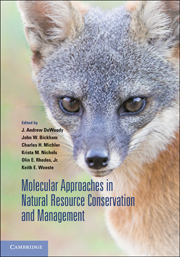Book contents
- Frontmatter
- Contents
- Contributors
- Preface
- 1 Biodiversity discovery and its importance to conservation
- 2 Gene flow, biodiversity, and genetically modified crops: Weedy rice in Thailand
- 3 A community and ecosystem genetics approach to conservation biology and management
- 4 Vertebrate sex-determining genes and their potential utility in conservation, with particular emphasis on fishes
- 5 Historical and contemporary dynamics of adaptive differentiation in European oaks
- 6 Association genetics, population genomics, and conservation: Revealing the genes underlying adaptation in natural populations of plants and animals
- 7 Hybridization in threatened and endangered animal taxa: Implications for conservation and management of biodiversity
- 8 Pollen and seed movement in disturbed tropical landscapes
- 9 Implications of landscape alteration for the conservation of genetic diversity of endangered species
- 10 Integrating evolutionary considerations into recovery planning for Pacific salmon
- 11 Using molecular methods to improve the genetic management of captive breeding programs for threatened species
- 12 Wildlife reintroductions: The conceptual development and application of theory
- 13 Evolutionary toxicology
- Index
- Plates
- References
3 - A community and ecosystem genetics approach to conservation biology and management
Published online by Cambridge University Press: 05 July 2014
- Frontmatter
- Contents
- Contributors
- Preface
- 1 Biodiversity discovery and its importance to conservation
- 2 Gene flow, biodiversity, and genetically modified crops: Weedy rice in Thailand
- 3 A community and ecosystem genetics approach to conservation biology and management
- 4 Vertebrate sex-determining genes and their potential utility in conservation, with particular emphasis on fishes
- 5 Historical and contemporary dynamics of adaptive differentiation in European oaks
- 6 Association genetics, population genomics, and conservation: Revealing the genes underlying adaptation in natural populations of plants and animals
- 7 Hybridization in threatened and endangered animal taxa: Implications for conservation and management of biodiversity
- 8 Pollen and seed movement in disturbed tropical landscapes
- 9 Implications of landscape alteration for the conservation of genetic diversity of endangered species
- 10 Integrating evolutionary considerations into recovery planning for Pacific salmon
- 11 Using molecular methods to improve the genetic management of captive breeding programs for threatened species
- 12 Wildlife reintroductions: The conceptual development and application of theory
- 13 Evolutionary toxicology
- Index
- Plates
- References
Summary
INTRODUCTION
The emerging field of community and ecosystem genetics has so far focused on how the genetic variation in one species can influence the composition of associated communities and ecosystem processes such as decomposition (see definitions in Table 3–1; reviews by Whitham et al. 2003, 2006; Johnson & Stinchcombe 2007; Hughes et al. 2008). A key component of this approach has been an emphasis on understanding how the genetics of foundation plant species influence a much larger community. It is reasoned that because foundation species structure their ecosystems by creating locally stable conditions and provide specific resources for diverse organisms (Dayton 1972; Ellison et al. 2005), the genetics of these species as “community drivers” are most important to understand and most likely to have cascading ecological and evolutionary effects throughout an ecosystem (Whitham et al. 2006). For example, when a foundation species’ genotype influences the relative fitness of other species, it constitutes an indirect genetic interaction (Shuster et al. 2006), and when these interactions change species composition and abundance among individual tree genotypes, they result in individual genotypes having distinct community and ecosystem phenotypes. Thus, in addition to an individual genotype having the “traditional” phenotype that population geneticists typically consider as the expression of a trait at the individual and population level, community geneticists must also consider higher-level phenotypes at the community and ecosystem level. The predictability of phenotypes at levels higher than the population can be quantified as community heritability (i.e., the tendency for related individuals to support similar communities of organisms and ecosystem processes; Whitham et al. 2003, 2006; Shuster et al. 2006).
- Type
- Chapter
- Information
- Publisher: Cambridge University PressPrint publication year: 2010
References
- 13
- Cited by



